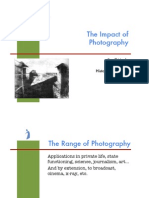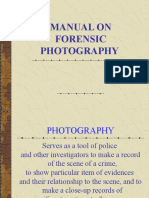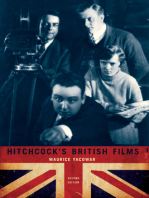Wester Beck
Uploaded by
ezdpWester Beck
Uploaded by
ezdp11
LEICA
Leica Cameras and the History of Photography
The Black Box
Colin WesterbeCk
William Henry Fox Talbot and Dr. Oskar Barnack had, perhaps, similar motives for 18x24mm that was then standard for motion pictures. This, he realized, could their photographic inventions. Both were frustrated artists. Talbot had attempted not only enhance projection of movies but make possible enlargement of photo make drawings of Lake Como on his honeymoon, and his unequivocal failure tographic prints from negatives without loss of quality. It was a Eureka! mo(the sketches, which survive, confirm his own opinion in the matter) prompted ment. As early as 1905, when hed lugged a view camera and plate film with him to investigate whether an optical-mechanical-chemical substitute might not him on Sunday hikes in the Thringer Wald, hed wondered whether a more be possible to benefit others as inept as he. Likewise, in the late 19th century, portable camera system couldnt be devised.3 Here, in the experiment with young Barnack also had artistic aspirations. But his father, wanting to find him a movie film, was the answer. more sensible trade than painting, had apprenticed him to a master mechanic Less fortuitous was the timing of this discovery. Leitz gave Barnack the instead.1 The upshot was that, 75 years after Talbot invented photography as a go-ahead to create a prototype still camera that could be loaded with the negative-positive process of image making, Barnack improved on the process by 24x36mm roll film. (The number of 36 frames on a roll was determined, inventing the Leica camera. legend has it, by the wingspan of Barnacks arms when fully extended.4) Then As the heir to a Wiltshire estate that had been in his family for over 200 years, Talbot was the very embodiment of the aristocratic tradition of the en- when the camera, known as the Ur-Leica, was ready, Barnack went out to lightened amateur. He saw his invention as an aid toindeed, a form ofart, test it, making an exposure of a man in uniform posting a notice in a public square. Unfortunately, the date was August 2, 1914, and the notice was Kaiser and the photography he made was the beginning of the Pictorialist aesthetic that would survive into the 20th century. Barnack, by contrast, was a com- Wilhelm IIs conscription order calling for a total national mobilization of the German people. Not until a decade later would Leitz and Barnack be able moner, a German craftsman-industrialist whose invention would democratize to fulfill the promise that the Ur-Leica held out and World War I forestalled. photography. Talbots camera was an instrument for dreamers; its fuzzy paper When the Leica I finally went into production in 1925, Barnack suggested negative appealed to the Romantic tastes of his age, to the nostalgia that ruins evoked as a subject matter. It lent itself to contemplation, whereas Barnacks Lilliput as the name for his camera.5 But others in the company who were shrewder at marketing settled instead on Leica, which was a portmanteau abcamera was built for intuition. It was fast, mobile, precisea prosthetic device breviation of Leitz and camera.6 of the imagination. It was something for the Modern era, a means to capture The delayed reaction to their dreams for the Leica notwithstanding, the sports, war, everyday life in the street and the politics of open societies. Inphotograph that Barnack had made that day in 1914 was prescient. It was stead of the backward glance of nostalgia, it served a forward-looking vision; both a bit of photojournalism and a street photograph rolled into one. On it was a progressive instrument suited to the accelerating pace of life in the the one hand, it was a seemingly innocuous scene of peoples daily activities early 20th-century. in public; on the other, it documented a momentous event that led to the firIn one of photo-historys little ironies, the Leica brought to fulfillment a potential that had at first been dismissed by Talbot as a hindrance. Tal- ing of the Guns of August. Photojournalism and street photography were the primary camera genres that the Leica was to serve, and nowhere would the bots wife teasingly called his first cameras mousetraps, because they were so small. The vagaries of the paper negative made this a great disadvantage, two be united more spectacularly than in the career of Henri Cartier-Bresson. Barnacks invention would never have been realized had he not had the assisso Talbot worked hard to increase the negatives size, which consequently required a view camera on a stand big enough to hold it. Although the late- tance of a brilliant lensmaker named Max Berek, who created the anastigmatic 19th century invention of the Kodak camera loaded with strip film again min- optics crucial to the cameras success.7 Berek was part of the Leitz firms heritage as manufacturers of microscopesa heritage of which the Leica was in iaturized photography, it was also a setback to the earlier crudeness of the a sense the ultimate beneficiary. The Leica was a microscope for the study of photographic image that had frustrated Talbot. (Moreover, the early Kodaks everyday life, as Bresson would demonstrate. precluded improvements by the photographer in the printing of the negatives Bresson acquired his first Leica in Marseilles in 1932, which happened to because the camera came pre-loaded with 100 exposures and had to be sent be the year that the Leica II came out. The camera immediately became the back to Kodak for processing.) Barnack solved the size problem by following grounding wire that permitted this nervy young Frenchman to use to good his motto, which was small negatives, large pictures.2 Fortuitously, a couple of years after coming to work in 1911 for the opti- effect the enormous amount of kinetic energy that he contained. Like Talbot, he was a son of privilege with an inherited income; but unlike the Englishcal firm owned by Ernst Leitz, Barnack was set the problem of stabilizing the man, he was also rebellious, bohemian and filled with wanderlust in his youth. mechanism that feeds film through movie cameras. Once hed achieved this, a Earlier, he had hied off to Africa, where hed hunted wild boar by torchlight. remaining difficulty was how to gauge the correct exposure for the film. This Perhaps thats why one of his favorite metaphors for photographing with his he solved by constructing a still camera in which strips of movie film could be Leica was hunting. The photographer must lie in wait, he said, watching loaded so that, after individual test shots at different exposures had been made and processed, the correct exposure for each scene could be determined. Fas- out for his prey, and have a presentiment of what is about to happen.8 As cinated with the potential that movie film had because it was so fine-grained, Anthony Lane pointed out in a New Yorker essay, Bresson sought endless analogies for the sensation that was engendered by the press of a shutter. A Barnack also experimented with a negative that was 24x36mm instead of the
potpourri of these came to mind when he was interviewed by Le Figaro in 1989: [The] Leica could be like a big passionate kiss, or then again like a shot from a gun, or the couch of a psychoanalyst.9 The mix of sex and violence leading to the analysts couch makes this remark provocative. (Remember that Susan Sontag characterized a photograph as a soft murder.) When he read the account I had written of him in my book Bystander, A History of Street Photography, co-authored with Joel Meyerowitz, Bresson protested, But you have put me on the analysts couch!10 Yet in the quotation above, he lies down there himself, of his own, free will. There is indeed an over-sexed quality to his early work from the 1930s; its youthful preoccupations are at times almost priapic. A psychoanalyst could have a field day with this stuff. Bressons are Freudian slips of the shutter, not the tongue, and theyre sometimes quite explicit, as when he lies on his back to photograph a man walking toward him at the moment that this figure is aligned with his crotch, like an erect phallus. (In another picture, the head and neck of a horse protrude into the background beyond a statue of a man or boy in the foreground, and to the same effect.) Then there are the pictures made from France to Mexico of his friends and acquaintances making love. Even when theres not explicit sexual content in Bressons early work, there is always an eroticism implicit in it; the presence of Eros in the larger sense is always felt. This is what makes the work great and what the Leica enabled him to bring into photography. When I said earlier that the Leica has served as a prosthesis for the imagination, I was enlarging on another Bressonian aphorism that his camera was the optical extension of my eye.11 I believe the truth is larger still: it is that the Leica brought into photography the life of the subconscious. It opened up the image to instincts, impulses and snap judgments that are always compromised in some measure by the rationality necessary for expression in other media with less immediacy. In Bressons work, this unquenchable spontaneity was nonetheless contained within an impeccably balanced frame. Although the whole process was completely pre-verbal, the Golden Mean in which he believed, his training in Analytic Cubism with Andr Lhote and the heritage of French rationalism all came into play in shaping his quick cats reflexes. He had a contemporary, however, whose compositions were more radical both aesthetically and politically. Aleksandr Rodchenko bought his first Leica in 1928, for 350 rubles.12 But years before he made photographs himself, hed made collages of photographs taken by others.13 Such jumbles of pictures crowded together on the page may have made him see as the potential subject of every photograph the skewed perspectives, abrupt disjunctions and bizarre juxtapositions of modern times. The modern city with its multi-story buildings, says an essay he wrote the same year he bought his Leica, the two- and three-story windows, the streetcars, automobiles, illuminated signs and billboards . . . have redirected . . . the normal psychology of visual perception. It would seem that only the camera is capable of reflecting contemporary life.14 His photography defies the equilibrium that Bressons maintains. He looked up at tall structures and down from atop them at the people below. His compositions reflect as a rule the progressive ideology of the Communist Revolution in which he believed. It is therefore a shame that one of his iconic imagesWoman with a Leica, made in 1934doesnt express his faith in international Communism so much as it regrets the persecution he was then suffering under Stalinism. Despite the upward thrust of the diagonal line the composition follows, the shadow that falls on the subject and setting casts a pall over the picture. Though Rodchenkos young student cuts an attractive figure in her white, knit dress, we feel as if she must be sitting in some kind of holding cell where guards who patrol on the grating overhead can keep an eye on her.15 Even Bresson, who was one of photographys great humanists, said that he chose the Leica as his instrument because he felt obliged to testify . . . to the scars of the world.16 Between Bressons photography and Rodchenkos, the two towering geniuses who dominated the early 20th centuryFreud and Marxwere both
well served. If Bressons work leads directly to Magnum and the picture-perfect compositions of W. Eugene Smith or Sebastio Salgado, Rodchenkos vertiginous photographs lead to the excesses of another Russian, Alexei Brodovitch, whose ultra-grainy, motion-blurred images in his 1945 book ballet verge on the chaos of incoherence. Whereas that book was a prototype for the gestural, rule-breaking photography of Robert Frank in The Americans, Rodchenkos dynamic experiments provide the background against which Garry Winogrands slashing light and tilted frames must be seen. And the Leica is the connection among them all. As the vehicle for both Bressons classics and Rodchenkos free radicals, the Leica has in effect said to us, as the poet Whitman did, Do I contradict myself? Very well then I contradict myself. (I am large. I contain multitudes.)17 It is a fitting tribute to the history of photography the Leica has made that, like prints from the negatives it created, it itself has become a collectors item. The rarer the model of the camera is, the more eagerly its sought after. The gold-plated, lizard-skinned Leica I Luxus of 1929; the 1926 Leica Compur that was designed to be cheap but, being a marketing failure, was produced in such low numbers that it has now become expensive; the Leica 250 Reporter with its over-sized magazine, and especially the mere 200 serial numbers equipped with a motorized film advance that were ordered by the Luftwaffe during World War II . . . any of these in mint condition can fetch top dollar.18 They are the real prizes of the Leicas history, but a few cameras that are even rarerthat are, indeed, uniqueare perhaps equally fascinating for the opposite reason: because theyre all in terrible condition. The Ur-Leica hand-made in 1913, for instance, has badly chipped body paint, numbers that are all but unreadable on the focusing ring and a lens mount whose face has been badly scraped by the lens cap screwed into it. These are the camera bodies whose scars are counterparts to the scars in the human condition to which Bresson said his photographs must testify. They are the cameras owned by the great photographersBruce Davidsons M2 that is, Lane said, pitted and peeled like the bark of a tree, or Winogrands M4 on which the metal is not just rubbed but visibly worn down beside the wind-on lever. Beyond such models that have suffered from fair wear and tear lie a few examples whose fate was unfair, though in at least one instance, damn lucky for the owner. This is the Leica II, now in the company museum at its headquarters in Solms, Germany, that a World War II reporter was carrying in the breast pocket of his jacket when the camera took a bullet intended for its owner, thereby saving his life.19 Leicas have survived every disaster that can befall man or machine ranging from fire to ice. The camera now nicknamed the iceman is a Leica II recovered from a glacier at Wielinger Kees in Upper Thuringia, over 7,000 feet above sea level. Found in 1994, its serial number indicated that it had been sold in April, 1932, to a man named Jansen. Also recovered, from the cameras magazine, was a roll of film. By contrast, the fire from which a Leica was recovered was the 1937 explosion of the Hindenburg as it docked at its mooring tower in New Jersey. The heat partially melted the lenses, which, like all Leitz lens elements since the companys founding, had been formed at a temperature of 1,200.20 In fact, Leicas were practically standard operating equipment on German zeppelin flightsso much so that a special carrying case lined with red velvet was designed to prevent condensation from forming on the cameras interior at high altitudes. The brass case tightly fitted to the contours of the camera was also intended to preserve it in a crash so that even if the passengers and crew perished, any film they may have shot could be recovered.21 Think of that! On top of all its other firsts, the Leica was the Ur-Black Box Flight Recorder. Nevertheless, the really exciting history this camera made was its down-to-earth use. Colin Westerbeck is Director, UCR California Museum of Photography
10
You might also like
- Hourglass Workout Program by Luisagiuliet 276% (21)Hourglass Workout Program by Luisagiuliet 251 pages
- Read People Like A Book by Patrick King-Edited57% (82)Read People Like A Book by Patrick King-Edited12 pages
- Livingood, Blake - Livingood Daily Your 21-Day Guide To Experience Real Health77% (13)Livingood, Blake - Livingood Daily Your 21-Day Guide To Experience Real Health260 pages
- Donald Trump & Jeffrey Epstein Rape Lawsuit and Affidavits83% (1016)Donald Trump & Jeffrey Epstein Rape Lawsuit and Affidavits13 pages
- The 36 Questions That Lead To Love - The New York Times94% (34)The 36 Questions That Lead To Love - The New York Times3 pages
- The 36 Questions That Lead To Love - The New York Times95% (21)The 36 Questions That Lead To Love - The New York Times3 pages
- Jeffrey Epstein39s Little Black Book Unredacted PDF75% (12)Jeffrey Epstein39s Little Black Book Unredacted PDF95 pages
- 14 Easiest & Hardest Muscles To Build (Ranked With Solutions)100% (8)14 Easiest & Hardest Muscles To Build (Ranked With Solutions)27 pages
- The 4 Hour Workweek, Expanded and Updated by Timothy Ferriss - Excerpt23% (954)The 4 Hour Workweek, Expanded and Updated by Timothy Ferriss - Excerpt38 pages
- CARTIER-BRESSON - Decisive Moment. The Eclectic Eye of Henry Cartier-Bresson100% (5)CARTIER-BRESSON - Decisive Moment. The Eclectic Eye of Henry Cartier-Bresson60 pages
- Photography Reality or Fiction History oNo ratings yetPhotography Reality or Fiction History o8 pages
- Leica M System: The Fascination of The Moment - Analog and DigitalNo ratings yetLeica M System: The Fascination of The Moment - Analog and Digital76 pages
- (Icons of Culture) Chris Dickie - Photography - The 50 Most Influential Photographers of All Time-B.E.S. Publishing (2010)No ratings yet(Icons of Culture) Chris Dickie - Photography - The 50 Most Influential Photographers of All Time-B.E.S. Publishing (2010)136 pages
- Final Forensic Photography and Video Project 1No ratings yetFinal Forensic Photography and Video Project 154 pages
- Chapter 7: Photography: - Lenses Also Have A Large Aperture Permitting Faster Shutter by TheNo ratings yetChapter 7: Photography: - Lenses Also Have A Large Aperture Permitting Faster Shutter by The4 pages
- London After Midnight: An English Translation of the 1929 French Novelization of the Lost Lon Chaney FilmFrom EverandLondon After Midnight: An English Translation of the 1929 French Novelization of the Lost Lon Chaney Film5/5 (1)
- Louis Le Prince: The Man Who Invented Film—Then Vanished ForeverFrom EverandLouis Le Prince: The Man Who Invented Film—Then Vanished ForeverNo ratings yet
- Benjamin - Little History of PhotographyNo ratings yetBenjamin - Little History of Photography12 pages
- A Brief History of Photography: Camera Obscura (Latin, Literally Translating To "Dark Room") Had Been in Existence100% (1)A Brief History of Photography: Camera Obscura (Latin, Literally Translating To "Dark Room") Had Been in Existence25 pages
- Paper On The Camera As The Photographer's VoiceNo ratings yetPaper On The Camera As The Photographer's Voice12 pages
- Introduction To Photography: From There To HereNo ratings yetIntroduction To Photography: From There To Here19 pages
- Walter Benjamin - A Short History of PhotographyNo ratings yetWalter Benjamin - A Short History of Photography22 pages
- The Photographer's Eye -- Szarkowski, John -- 2007 -- New York, Museum of Modern Art -- 9780870705274 -- 1158bd8cd03d9cd28864090f9e68ff03 -- Anna’s ArchiveNo ratings yetThe Photographer's Eye -- Szarkowski, John -- 2007 -- New York, Museum of Modern Art -- 9780870705274 -- 1158bd8cd03d9cd28864090f9e68ff03 -- Anna’s Archive154 pages
- Broadway Digital Reissue Press Clips 7-22-09No ratings yetBroadway Digital Reissue Press Clips 7-22-097 pages
- Name:T.Gnanender Reddy ROLL NO:1841303109 Course:B.Sc 3 Year Collage:Ihm Shri ShaktiNo ratings yetName:T.Gnanender Reddy ROLL NO:1841303109 Course:B.Sc 3 Year Collage:Ihm Shri Shakti20 pages
- Jabatan Pengairan Dan Saliran Malaysia: Lampiran FNo ratings yetJabatan Pengairan Dan Saliran Malaysia: Lampiran F5 pages
- Androsova Toys - Rainbow Unicorn Free PatternNo ratings yetAndrosova Toys - Rainbow Unicorn Free Pattern25 pages
- Effect of Knitted Structure On The Properties of Knitted FabricNo ratings yetEffect of Knitted Structure On The Properties of Knitted Fabric5 pages























































































































